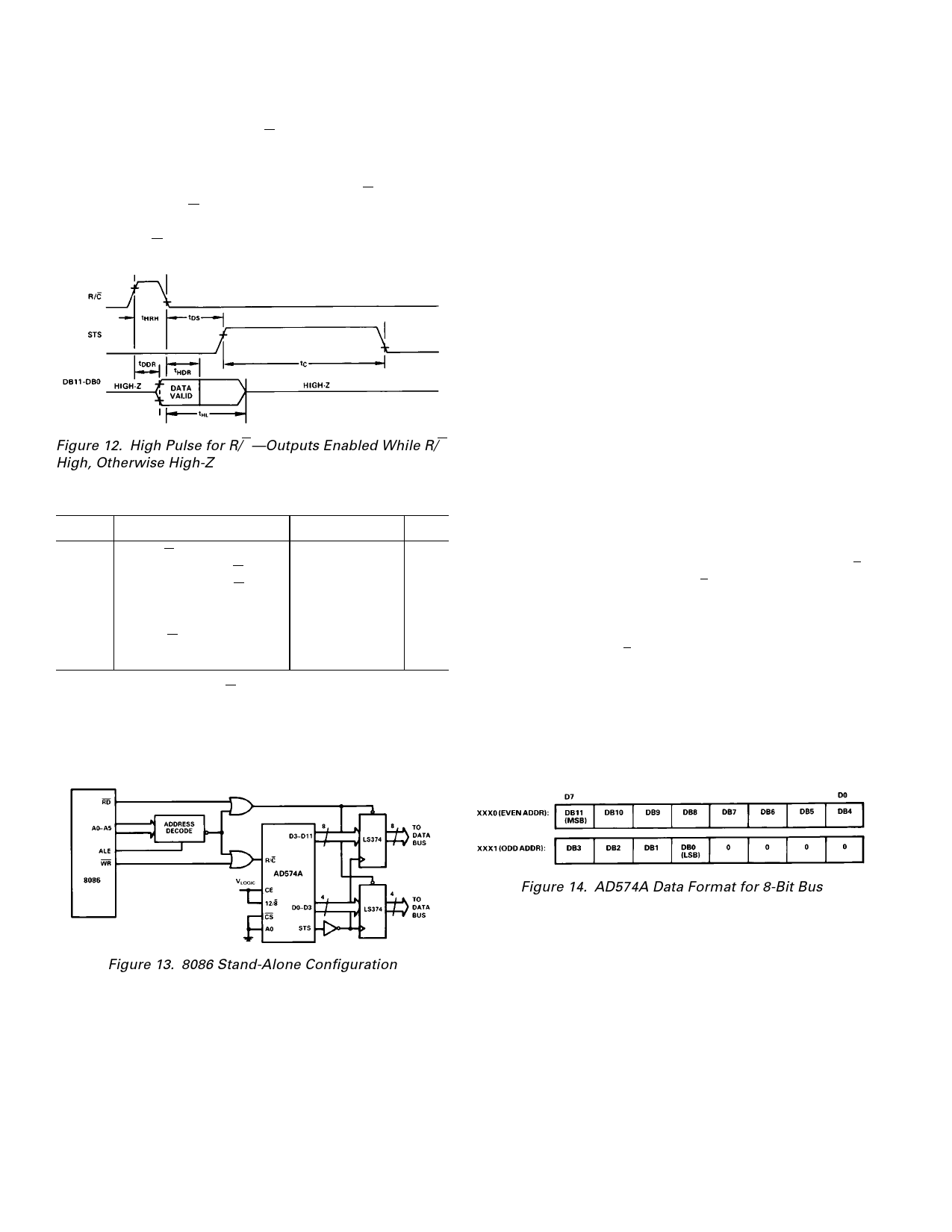AD574ATX2 查看數據表(PDF) - Analog Devices
零件编号
产品描述 (功能)
生产厂家
AD574ATX2 Datasheet PDF : 12 Pages
| |||

AD574A
to valid logic levels after the conversion cycle is completed. The
STS line goes high 600 ns after R/C goes low and returns low
300 ns after data is valid.
If conversion is initiated by a high pulse as shown in Figure 12,
the data lines are enabled during the time when R/C is high.
The falling edge of R/C starts the next conversion, and the data
lines return to three-state (and remain three-state) until the next
high pulse of R/C.
Figure 12. High Pulse for R/C—Outputs Enabled While R/C
High, Otherwise High-Z
Table IV. Stand-Alone Mode Timing
Symbol Parameter
Min Typ Max Units
tHRL
Low R/C Pulse Width
250
tDS
STS Delay from R/C
tHDR
Data Valid After R/C Low 25
tHL
Output Float Delay
tHS
STS Delay After Data Valid 300
tHRH
High R/C Pulse Width
300
tDDR
Data Access Time
ns
600 ns
ns
150 ns
1000 ns
ns
250 ns
Usually the low pulse for R/C stand-alone mode will be used.
Figure 13 illustrates a typical stand-alone configuration for 8086
type processors. The addition of the 74F/S374 latches improves
bus access/release times and helps minimize digital feedthrough
to the analog portion of the converter.
GENERAL A/D CONVERTER INTERFACE
CONSIDERATIONS
A typical A/D converter interface routine involves several
operations. First, a write to the ADC address initiates a conver-
sion. The processor must then wait for the conversion cycle to
complete, since most ADCs take longer than one instruction
cycle to complete a conversion. Valid data can, of course, only
be read after the conversion is complete. The AD574A provides
an output signal (STS) which indicates when a conversion is in
progress. This signal can be polled by the processor by reading
it through an external three-state buffer (or other input port).
The STS signal can also be used to generate an interrupt upon
completion of conversion, if the system timing requirements are
critical (bear in mind that the maximum conversion time of the
AD574A is only 35 microseconds) and the processor has other
tasks to perform during the ADC conversion cycle. Another
possible time-out method is to assume that the ADC will take
35 microseconds to convert, and insert a sufficient number of
“do-nothing” instructions to ensure that 35 microseconds of
processor time is consumed.
Once it is established that the conversion is finished, the data
can be read. In the case of an ADC of 8-bit resolution (or less),
a single data read operation is sufficient. In the case of convert-
ers with more data bits than are available on the bus, a choice of
data formats is required, and multiple read operations are needed.
The AD574A includes internal logic to permit direct interface
to 8-bit or 16-bit data buses, selected by connection of the 12/8
input. In 16-bit bus applications (12/8 high) the data lines
(DB11 through DB0) may be connected to either the 12 most
significant or 12 least significant bits of the data bus. The re-
maining four bits should be masked in software. The interface
to an 8-bit data bus (12/8 low) is done in a left-justified format.
The even address (A0 low) contains the 8 MSBs (DB11 through
DB4). The odd address (A0 high) contains the 4 LSBs (DB3
through DB0) in the upper half of the byte, followed by four
trailing zeroes, thus eliminating bit masking instructions.
It is not possible to rearrange the AD574A data lines for right
justified 8-bit bus interface.
Figure 14. AD574A Data Format for 8-Bit Bus
Figure 13. 8086 Stand-Alone Configuration
INTERFACING THE AD574A TO MICROPROCESSORS
The control logic of the AD574A makes direct connection to
most microprocessor system buses possible. While it is impos-
sible to describe the details of the interface connections for every
microprocessor type, several representative examples will be
described here.
SPECIFIC PROCESSOR INTERFACE EXAMPLES
Z-80 System Interface
The AD574A may be interfaced to the Z-80 processor in an I/O
or memory mapped configuration. Figure 15 illustrates an I/O
or mapped configuration. The Z-80 uses address lines A0–A7 to
decode the I/O port address.
An interesting feature of the Z-80 is that during I/O operations a
single wait state is automatically inserted, allowing the AD574A
to be used with Z-80 processors having clock speeds up to 4 MHz.
For applications faster than 4 MHz use the wait state generator
in Figure 16. In a memory mapped configuration the AD574A
may be interfaced to Z-80 processors with clock speeds of up to
2.5 MHz.
–10–
REV. B